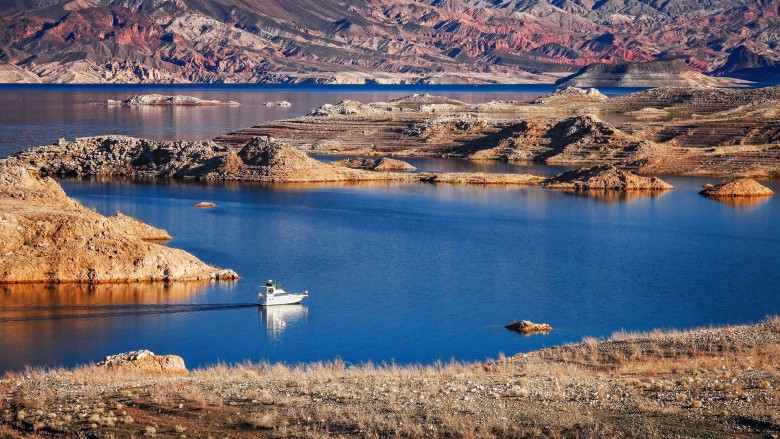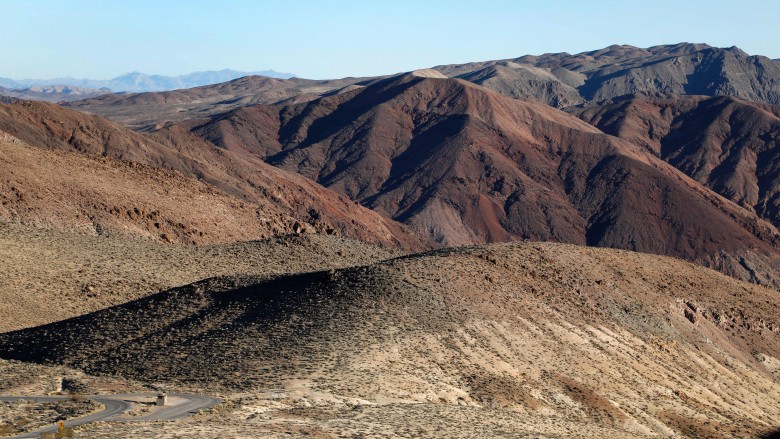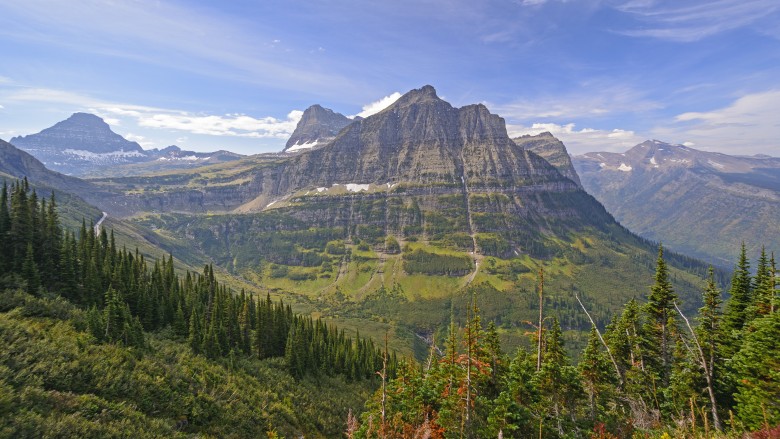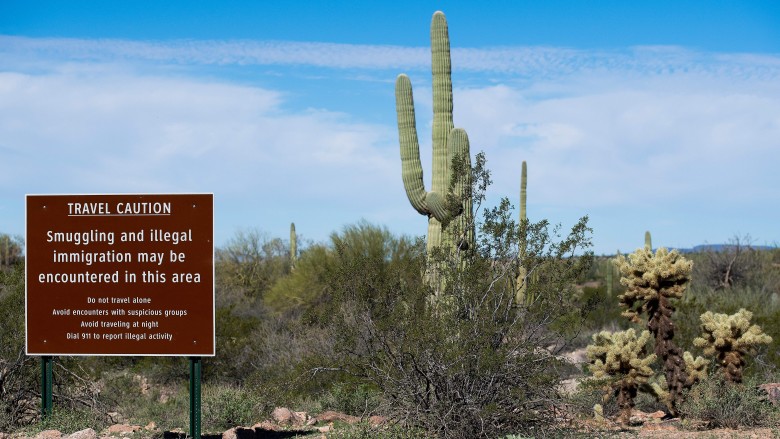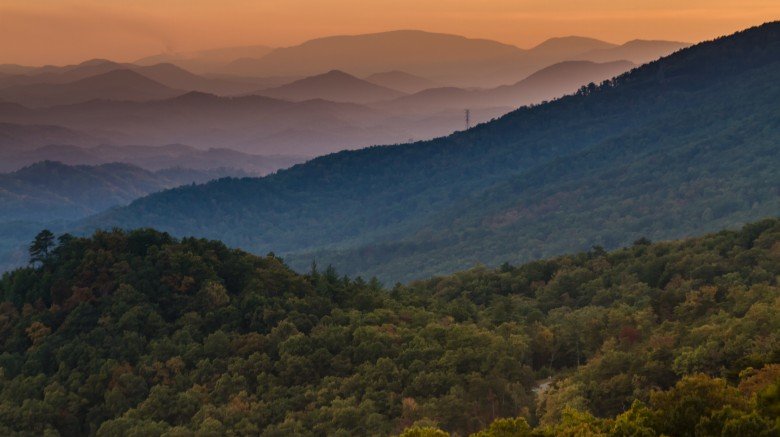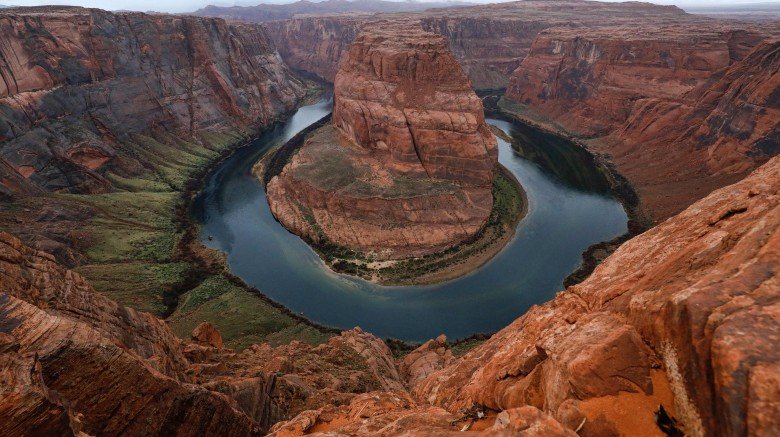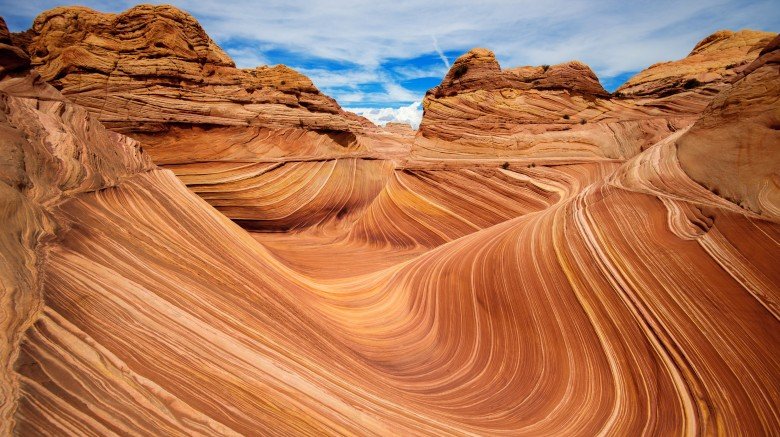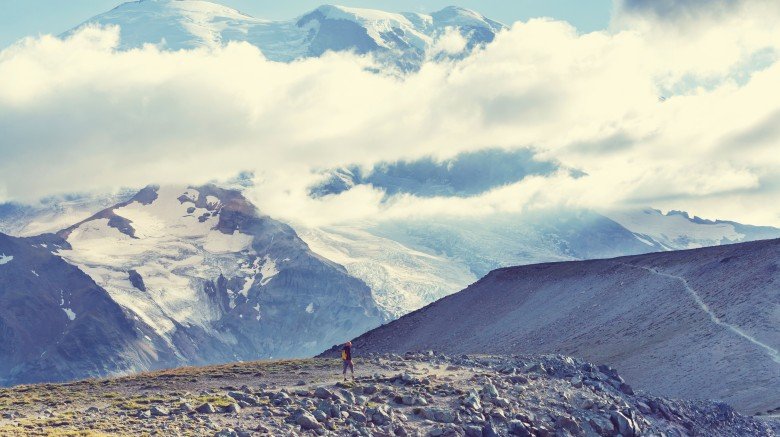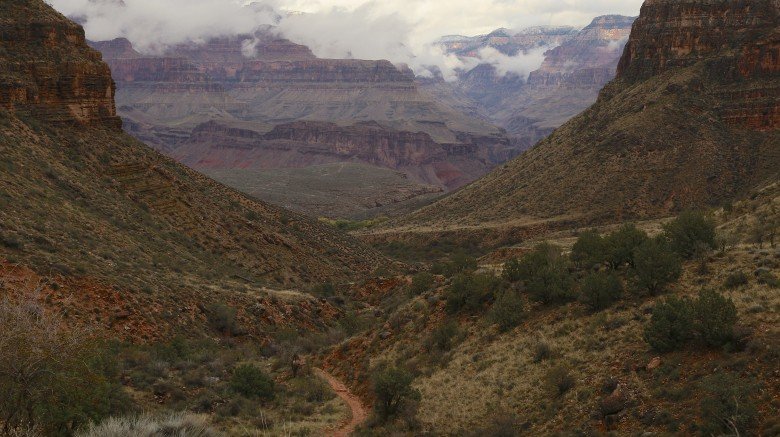Most Dangerous Camping Spots In The U.S.
There's a reason the United States is nicknamed "America the Beautiful." It's full of gorgeous natural landscapes. From snow-capped mountains to unforgiving deserts, the National Park System is home to 84 million acres of land, which is visited by more than 300 million people each year. For outdoor lovers, it's heaven on earth. But for less experienced adventurers, treks into these American wilderness escapes can be downright hellish.
Lake Mead National Recreation Area
Lake Mead, which straddles the border of Nevada and Arizona and is part of the Colorado River, is the largest reservoir in the US and something of an oasis in an otherwise desert area. With picturesque rugged terrain and sparkling waters, Lake Mead offers up outdoor fun for guests of all ages, and just 24 miles from glitzy Las Vegas, it's a quieter getaway from the bright city lights.
But that doesn't mean it's a total jackpot. Park rangers consistently rank it among the most dangerous parks in the country for several reasons. It may be one of the National Park Service's top ten most visited parks, but that comes with plenty of downsides like boating and auto accidents and especially drowning deaths, very few of which seem to involve alcohol. "It's really not the party crowd," Lake Mead spokeswoman Christie Vanover told the Associated Press. "It's people who don't understand the power of the lake. Some people think it's like a swimming pool." The park has also had trouble with assaults and other violent crimes, which don't exactly make for a tranquil vacation spot.
Death Valley
Could the name Death Valley be any more obvious? True, this vast national park that's primarily located in California has its upsides. Despite its name, Death Valley is home to plenty of living creatures from desert bighorn sheep to rattlesnakes to tortoises that can live up to 80 years. With over three million designated wilderness acres for exploration, Death Valley is a great place for hiking, mountain biking, camping, and even birdwatching. For those who enjoy stargazing, the park also offers unparalleled views of the Milky Way, even earning an International Dark Sky Association certification. Astronomers come from all over, often braving plunging temps to get a glimpse of the latest celestial event.
But there are plenty of reasons Death Valley has earned its ominous name. The extreme temperatures alone can be incredibly dangerous to unprepared visitors. During the summer months, temperatures often exceed 120 degrees, especially in low-lying areas, leading to dehydration and sometimes death. A family of German tourists in 1996 mysteriously went missing until human bones were found in 2009 in the beautiful but remote Butte Valley. "It's what I'm beginning to call death by GPS," Death Valley wilderness coordinator Charlie Callagan remarked. "People are renting vehicles with GPS, and they've no idea how it works, and they're willing to trust the GPS to lead them into the middle of nowhere."
Death Valley also has another unfortunate claim to fame: the Barker Ranch on its southwestern corner once played hideout to serial killer Charles Manson and his Family in the months immediately following their infamous Tate-LaBianca murders in 1969. In fact, we have Death Valley park rangers to thank for initially arresting Manson and his followers after the group was spotted vandalizing park property. Park rangers are true heroes.
Glacier National Park
This gorgeous park sits along the border of Montana and the Canadian provinces of Alberta and British Columbia. Along with Waterton Lakes National Park across the border in Canada, Glacier National Park was designated an International Biosphere Reserve, a world heritage site, and the world's first international peace park. The park has over 734 hiking trails, 13 campgrounds, and plenty of opportunities for fishing, boating, biking, and skiing. Life definitely doesn't move at a glacial pace around here.
Unfortunately, visiting is no walk in the park for many. On average, 2–3 people die each year on its land from a variety of causes. Though drowning deaths top the list, Glacier National Park has different challenges than many parks, like rockslides, avalanches, and other falling objects that have crushed motorists and climbers. "If you bore down in the statistics, you find out many of those victims were alone and got themselves in trouble," Eric Gabriel, branch chief for ranger activities in Glacier told the Great Falls Tribune. This is especially true for inexperienced day-hikers who fall victim to slippery trails or stray too far from marked trails, like a 74-year-old man who accidentally stepped over a retaining wall to take a picture and fell 500 feet to his death in 1999.
But at least 10 visitors to Glacier National Park have died in a far more grisly way: grizzly bear attacks. The most famous deaths occurred in 1967 when two 19-year-old women were mauled to death on the same night at different campsites within the park. The event has become known as the Night of the Grizzlies, which spawned a documentary for PBS in 2010 and prompted the National Park Service to change its garbage dumping policies, eliminating a food source for the fuzzy fearsome animals and lowering the risk of attacks for visitors. If only someone had told Leonardo DiCaprio that in The Revenant.
Organ Pipe Cactus National Monument
Named for the tall breed of cactus that dominates this stretch of the Sonoran Desert in Arizona, Organ Pipe Cactus National Monument is both desolate and beautiful. In 1976, the United Nations designated it as an International Biosphere Reserve so its lands are protected and available for scientific research on desert ecosystems, climate change, and the ongoing human impact on desert life. Organ Pipe Cactus National Monument is one of the most biodiverse desert areas in the world because of its various plant, lizard, and mammal inhabitants, including America's only jaguar population, though poaching and a possible border wall could endanger the wildcats to the point of extinction.
But the desert terrain is also home to a very different type of predator, which has consistently earned the park a reputation as one of the deadliest in the nation. Drug smugglers and human traffickers have often cut through the wilderness on their way to and from Mexico, with which the park shares 31 miles of border. The Kris Eggle Visitor Center is named for a park ranger who died during a bloody standoff between two smugglers fleeing Mexican authorities in 2002. In fact, from 2003 to 2014, 70 percent of the park was closed due to illegal activity. But thanks to the cooperation of Border Control, Organ Pipe Cactus National Monument has reopened to the public with better security, including more staff and surveillance. That's one less prickly situation to deal with.
Great Smoky Mountains National Park
Great Smoky Mountains National Park in Tennessee and North Carolina is America's most visited national park and not just because it played childhood home to country music icon Dolly Parton. This densely forested and mountainous area offers opportunities for hiking, camping, skiing, and horseback riding, plus plenty of historical exploration The park protects and preserves over 80 structures and tons of artifacts from early settlers and from the earliest Native American inhabitants, who named the area "Shaconage" aka "place of blue smoke." And given its often breathtaking views especially when the fog rolls in, there's no question it's a popular destination for motorists driving through its winding roads.
However, automobile accidents account for most of the deaths in the park each year due to distracted drivers, sharp turns, and occasionally slippery roads. While the Smokies also have several gorgeous waterfalls, these areas too have proven fatal due to either falls or drowning deaths. In late 2016, forest fires claimed at least 14 lives.
There's another issue at the park that has caused haziness over the years: the whereabouts of several missing persons. Seven-year-old Dennis Martin disappeared on June 14, 1969, during a prank gone wrong, leading to a costly three-month search with thousands of volunteers that ultimately turned up nothing. Sixteen-year-old Trenny Lynn Gibson went missing during a high school field trip in October 1976, but no classmates remember seeing her past 3 p.m. on the day of their hike. Similarly, in September 1981, 58-year-old Thelma "Polly" Melton was out hiking with friends when she hiked ahead and vanished, despite being familiar with trails from previous hikes. Lesson? Don't get yourself alone in the wilderness.
Glen Canyon National Recreation Area
Stretching from northern Arizona into the southern portion of Utah, Glen Canyon National Recreation Area is just that: an outdoor area perfect for fun in the blazing southwestern sun. With 1.25 million acres of land, the park is home to stunning cliff formations, the winding San Juan and Colorado Rivers, the infamous Rainbow Bridge, wilderness trails, and Lake Powell. Glen Canyon also is one of the largest preservations of Mesozoic strata anywhere in the world, fascinating paleontologists. The scenic views and pristine waters have made Glen Canyon an especially popular destination for water-based activities like boating, kayaking, swimming, and fishing.
Glen Canyon is also a pretty dangerous travel destination. Lake Powell especially is notorious for boating accidents and drownings. In June 2013 alone, six deaths occurred over a ten-day span. Though cliff-jumping over 15 feet has been banned for several years, videos of stunts on YouTube have inspired some risk-takers to keep pushing limits, putting them in serious danger and killing others. At Glen Canyon, pushing the limits is no laughing matter.
The Wave
"You can't call yourself a landscape photographer if you haven't snapped a photo or two of the Wave," wrote Hugo Martin of the LA Times. The rock formation along the northern Arizona border is, admittedly, beyond photogenic thanks to its stunning, ribbon-like horizontal and vertical stripes of calcified Jurassic Navajo sandstone.
Part of Vermillion Cliffs National Monument, the Wave is one of the most photographed landscapes in North America. It's also one of the most remote. Because of the sensitivity of the rock formations, only 20 visitors per day are allowed to hike out to the Wave. Permits must be obtained either via an online lottery months ahead of time or through a daily local lottery held at the Grand Staircase Escalante National Monument in nearby Kanab, Utah. Winners are given a map and directions to the Wave, but then they're flying solo.
It's nicknamed "the devil's playground," which is never a good sign. Temperatures in the Wave can climb well past the 100-degree mark. Faced with unmarked trails and confusing terrain, hikers hoping to reach the near-psychedelic rock formation do so at their own risk. And often, they never make it, like 27-year-old Elisabeth Bervel, who died of cardiac arrest during a trek celebrating her fifth wedding anniversary in 2013. In one month alone that year, three people died from excessive heat and cardiac arrest. A sheriff's report about the Bervel's unfortunate death stated: "The couple of extra hours in the heat and hiking in the sand took their toll on Elisabeth and her legs finally gave out and she could go no farther. [Her husband] hiked for a ways to find a cell phone signal and made a call for help."
Those who are successful find heaven in hell, but if you aren't prepared for the challenges, go ahead and wave goodbye.
Mount Rainier National Park
At over 14,000 feet above sea level, Mount Rainier is the tallest peak in Washington state and the Cascade Mountains of the Pacific Northwest. It also happens to be an active volcano. Though it last erupted around 1,000 years ago, it still occasionally causes small earthquakes.
But the extreme conditions can prove tricky to less experienced outdoor adventurers. Temperatures near the summit of Mount Rainier, even in the summer, are brutally cold, and harsh winds can cause avalanches. Hypothermia has claimed the lives of several hikers who weren't prepared for the bitter conditions. But one spot in particular has proven especially deadly over the years: Liberty Ridge.
Less than 2 percent of hikers attempt the climb, but it accounts for 25 percent of deaths on summit climbs in the park. Though it offers stunning views and gained popularity due to its inclusion in a 1979 guidebook called Fifty Classic Climbs of North America, the difficulty of the hike is not for the faint of heart. In 2014, six climbers fell 3,000 feet to their deaths while trying to reach the summit. It was the single worst accident the park had experienced since the 1980s when 11 people died in an avalanche.
The Grand Canyon's Bright Angel Trail
The Grand Canyon is one of America's most popular destinations, attracting over four million visitors each year to its spectacular winding rock plateaus and basins. It's also one of the most significant geological areas in the world, as it contains evidence of four different geological periods, tons of fossils, and innumerable caves. Those seeking to hike to its bottom have to trek a full mile down.
One such hike, however, is not quite so grand for many unprepared visitors. Considered the premiere hike in the park, the Bright Angel Trail offers visitors a steep trail to the Canyon's bottom and up north to the Kaibab Trail and Colorado River. Though the Park Service maintains that it's the safest trail in the park with several water, phone, and ranger stations along its path, some visitors still manage to fall victim to "the devil's Corkscrew." Hikers have died of heat stroke and heart attacks along it.
The Park Service constantly warns hikers of the dangers of heat, dehydration, and trying to hike from the rim to the river in a single day, but many don't listen, especially during the summer months when both the heat and number of visitors reach their peak. The Rangers have a saying about the hike during the summer: "It's for fools and rangers making rescues." Hiker assists increase as the temperatures rise, with Rangers having to rescue clueless and inexperienced guests, especially near Indian Gardens where temperatures soar. "There's no tougher place to hike, except extreme mountaineering," Grand Canyon Park Ranger Bev Perry told the LA Times. Its name may be Bright Angel, but it sure is a devil of a hike.
